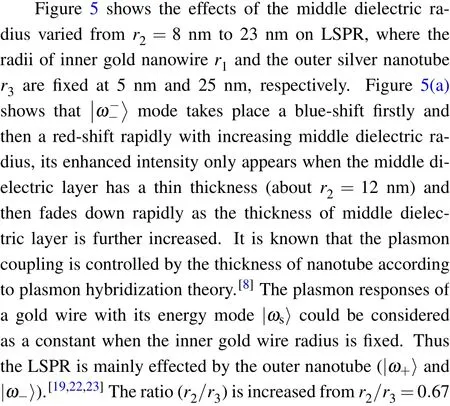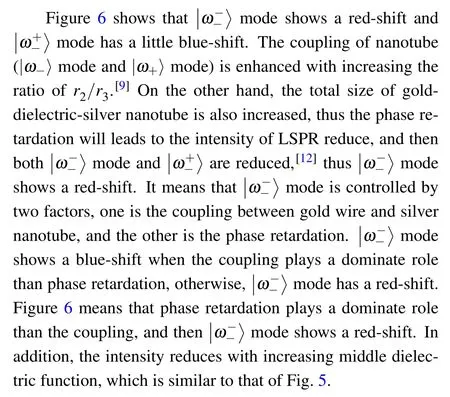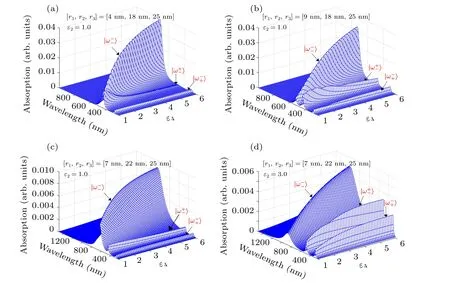Optical absorption tunability and local electric field distribution of gold-dielectric-silver three-layered cylindrical nanotube*
Ye-Wan Ma(马业万), Zhao-Wang Wu(吴兆旺), Yan-Yan Jiang(江燕燕), Juan Li(李娟), Xun-Chang Yin(尹训昌),Li-Hua Zhang(章礼华), and Ming-Fang Yi(易明芳)
School of Mathematics and Physics,Anqing Normal University,Anqing 246133,China
Keywords: localized surface plasmon resonance,gold-dielectric-silver nanotube,quasi-static approximation,plasmon hybridization theory
1. Introduction
Special optical properties of noble metal nano-structures(i.g., gold and silver)demonstrate different optical properties in comparison with bulk metal materials, thus optical properties of nobel metal nano-structures have attractive interests due to the intense light absorption of localized surface plasmon resonance (LSPR). LSPR originates from the collective oscillation of conduction electrons in accordance with the incident wave frequency,[1,2]and the results show that both the intensity and LSPR peak position can be well tuned by varying the nano-structure size, shape, structure and surrounding medium function.[3]Therefore, the LSPR can be well tuned by adjusting the parameters of the particle size, shape, component and surrounding medium function. LSPR has been widely used in chemical and biological sensing,[4]tunabilty of Fano resonance[5]and surface-enhanced Raman spectroscopy(SERS).[6]The studies show that core-shell nano-particle is one of the most efficient methods to vary the LSPR wavelength from ultraviolet to infrared region. Xiaet al.have synthesized three-layered gold-silica-gold nanoshell with a size sub-100 nm,and the results shows that gold-silica-gold nanoshell can generate a strong surface plasmon resonance.[7]Halaset al.have studied the optical properties of concentric nanoshell structures using the plasmon hybridization theory, and suggested the complex structure of nanoshell can be viewed as a sum of the contributions of the dipolar and higher order hybrid multipolar plasmon modes,[8,9]which provides a new approach to well analyze the optical properties of nanoshell.Wanget al.have studied a novel plasmonic refractive index sensor based on gold/silicon structure and used it as a sensor in biochemistry.[10]Debelaaet al.have reported surface plasmon resonances in ellipsoidal bimetallic nanoparticles using the Laplace equation, and the results show that the LSPR depends on surrounding dielectric function.[11]Wuet al.have studied optical properties of bimetallic gold and silver alloy nanoshell for biomedical applicationsin vivowith Mie scattering theory and plasmon hybridization theory,and the result indicates that the lower energy mode has a distinct red-shift with increasing core radius.[12]Schiditabaret al.have investigated the resonance light scattering properties of silver-dielectricsilver nanoshell based on quasi-static approach, and the results show that LSPR are optimized by tuning the geometrical dimensions.[13]Based on the light absorption spectra properties of a bimetallic multilayer nanoshell (silver-dielectricsilver,gold-dielectric-silver and silver-dielectric-gold),the results show that relatively small thickness of outer silver shell and large dielectric constants of middle dielectric layer of gold-dielectric-silver nanoshell are suitable to obtain the triple plasmon resonance.[14]
Recently, the optical properties of nanotube have also been widely investigated and applied in biological tissues,nanosensors, optical devices, optical data storage and some regions. Bahariet al.have studied metal-air-metal cylinder theoretically, and given the effect of increasing the interwall spacing between two metals on plasmon dispersion relation.[15]Wang have reported that cylindrical core-shell nanorods can obtain Fano resonance by adjusting the field coupling between cavity and gold surface,which could be applied in optical devices.[6]Zhuet al.have investigated the effect of local dielectric environment on the resonance light scattering of Au-Ag bimetallic nanotube, and the result presents a potential for design and fabrication of optical refractive index nanosensors.[16]Gaoet al.have investigated the geometrical parameters focusing and enhancing near field in infinite circular silver-dielectric-silver cylinder with quasi-static approach, what is more, the study shows that local electric field enhancement provides the potential applications for optical data storage.[17]A stronger local field enhancement can be obtained in the middle dielectric wall between inner silver and outer tube at the resonance wavelength.[18]Moradi has theoretically studied how the plasmon excitations of the system depend on the dielectric difference between the core and shell in coated metallic nanowires.[19]Zhuet al.have reported the local dielectric environment dependent local field enhancement properties in double concentric silver nanotube using plasmon hybridization method and quasi-static calculation.[20]Daneshfaret al.have studied optical and spectral tunability of multilayer spherical and cylindrical nanoshell with quasi-static theory.[21]Wuet al.have studied the multiple Fano resonance of nanrod and nanoring, which has been applied in refractive index sensing and high-sensitivity biosensors.[22]The optical absorption of three-layered nanoshell shows that the LSPR can be well adjusted the parameters of nanoshell.[23]
Most of previous studies have mainly focused on golddielectric-gold nanotube, where the core and outer shell have the same nobel metal,while the core and outer shell with different nobel metals are less reported. In this paper, we theoretically investigate the effects of inner gold nanowire radius,the dielectric functions of inner core and surrounding medium on gold-dielectric-silver nanotube. In addition,its sensor and local electric field factor are also reported. Local electric field factor is one of the important parameters to affect the surface enhanced Raman scattering, nonlinear optical response and optical data storage. Our study provides a method to broaden the potential applications of gold-dielectric-silver nanotube in biological tissues, sensor, optical data storage and other regions.
2. Model and theoretical method
In this paper,we study the absorption properties of golddielectric-silver three-layered nanotube. The geometry of an infinite three-layered gold-dielectric-silver nanotube is given in Fig. 1. The geometry consists of an infinite length gold nanowire with a radiusr1and dielectric functionε1,the outer silver nanotube with a thicknessr3−r2and dielectric functionε3. The nanowire and nanotube are separated by a middle dielectric layer with a thicknessr2−r1and dielectric functionε2, and the total nanotube is suspended in the surrounding medium with dielectric functionε4. The total diameter of gold-dielectric-silver nanotube is much smaller than the incident wavelength, thus the surface charges in gold-dielectricsilver nanotube oscillate like a simple electric dipole and then the quasi-static approximation can be used to calculate the optical property of absorption cross section.[24]The diameter of gold-dielectric-silver nanotube is much smaller than the incident wavelength, thus the induced field in the region outside the shell likes a dipole. The absorption cross section can be gotten from polarizability by using the scattering theoryCabs=kIm(α),[25]whereαis the polarizability.

Fig.1. The geometry of gold-dielectric-silver nanotube.
In Drude model,[26]the frequency-dependent inner gold nanowireε1and outer silver shellε3have real and imaginary components. The dielectric functions of gold and silver could be written as follows:

whereεexp(ω)is the experimental bulk dielectric function.[27]ωp=1.37×1016Hz denotes the plasma frequency of bulk gold andωp= 1.364×1016Hz for silver,γbulk= 1.07×1013Hz is electron collision damping in the gold andγbulk=3.23×1013Hz for silver.VF=1.4×106m/s is the Fermi velocity,R=r3−r2for silver nanotube andR=2r1for inner gold nanowire.
3. Results and discussion




Fig. 2. (a) Absorption spectra of gold-dielectric-silver nanotube calculated for a single cylindrical gold nanowire, dielectric-silver nanotube and gold-dielectric-silver nanotube, (b)-(d) the local electric field factor of gold-dielectric-silver nanotube at each LSPR wavelength λ =318 nm,λ =484 nm and λ =750 nm,respectively.
3.1. The effect of inner nanowire radius with different middle dielectric functions on LSPR of golddielectric-silver nanotube





Fig. 3. The effect of inner gold nanowire radius r1 on absorption spectra of gold-dielectric-silver nanotube with [r2,r3]=[15 nm,25 nm] and ε4 =4.0.(a)ε2=2.0,(b)ε2=4.0 and(c)ε2=6.0,respectively.

Fig.4.The effectofinner gold nanowire radiusr1 onabsorption spectra of gold-dielectric-silver nanotube with[r2 −r1,r3]=[5 nm,25 nm]and ε4=4.0.(a)ε2=2.0,(b)ε2=4.0 and(c)ε2=6.0,respectively.



3.2. The effect of middle dielectric layer radius on LSPR of gold-dielectric-silver nanotube


Our next goal is to study the effect of outer middle dielectric thickness on LSPR,where the inner gold nanowire radiusr1and outer nanotube thicknessr3−r2are fixed atr1=5 nm andr3−r2=5 nm, while the middle dielectric radiusr2is varied fromr2=10 nm to 20 nm,which is given in Fig.6.

Fig.5.The effect of middle dielectric radius r2 on absorption spectra of gold-dielectric-silver nanotube with[r1,r3]=[5 nm,25 nm]and ε4=4.0:(a)ε2=2.0,(b)ε2=4.0 and(c)ε2=6.0,respectively.

Fig. 6. The effect of middle dielectric radius r2 on absorption spectra of gold-dielectric-silver nanotube with [r1,r3 −r2]=[5 nm,5 nm] and ε4 =4.0:(a)ε2=2.0,(b)ε2=4.0 and(c)ε2=6.0,respectively.

3.3. The effect of outer silver radius on LSPR of golddielectric-silver nanotube



Fig.7. The effect of outer nanotube radius r3 on absorption spectra of gold-dielectric-silver nanotube with[r1,r2]=[5 nm,10 nm]and ε4=4.0:(a)ε2=2.0,(b)ε2=4.0 and(c)ε2=6.0,respectively.

Fig. 8. The effect of the ratio of r1/r2/r3 =constant on absorption spectra of gold-dielectric-silver nanotube with r1 =5 nm and ε4 =4.0: (a) ε2 =2.0,(b)ε2=4.0 and(c)ε2=6.0,respectively.
3.4. The effect of surrounding medium dielectric function on LSPR of gold-dielectric-silver nanotube





Fig.9. The effect of surrounding medium ε4 on gold-dielectric-silver nanotube. (a)[r1,r2,r3]=[4 nm,18 nm,25 nm]and ε2=1.0,(b)[r1,r2,r3]=[9 nm,18 nm,25 nm]and ε2=1.0,(c)[r1,r2,r3]=[7 nm,22 nm,25 nm]and ε2=1.0,and(d)[r1,r2,r3]=[7 nm,22 nm,25 nm]and ε2=3.0.
3.5. The local electric field factor of gold-dielectric-silver nanotube


Fig.10. The local electrical feild factor of gold-dielectric-silver nanotube at the resonance wavelength corresponding tomode with different middle dielectric radii and middle dielectric functions. (a) [r1,r2]=[5 nm,20 nm], [ε2,ε4]=[1.0,4.0] and λ =716 nm, (b) [r1,r2]=[18 nm,20 nm], [ε2,ε4]=[1.0,4.0]and λ =1158 nm,(c)[r1,r2]=[5 nm,10 nm],[ε2,ε4]=[1.0,4.0]and λ =500 nm,(d)[r1,r2]=[5 nm,10 nm],[ε2,ε4]=[4.0,4.0]and λ =658 nm.
4. Conclusions



- Chinese Physics B的其它文章
- Numerical investigation on threading dislocation bending with InAs/GaAs quantum dots*
- Connes distance of 2D harmonic oscillators in quantum phase space*
- Effect of external electric field on the terahertz transmission characteristics of electrolyte solutions*
- Classical-field description of Bose-Einstein condensation of parallel light in a nonlinear optical cavity*
- Dense coding capacity in correlated noisy channels with weak measurement*
- Probability density and oscillating period of magnetopolaron in parabolic quantum dot in the presence of Rashba effect and temperature*

